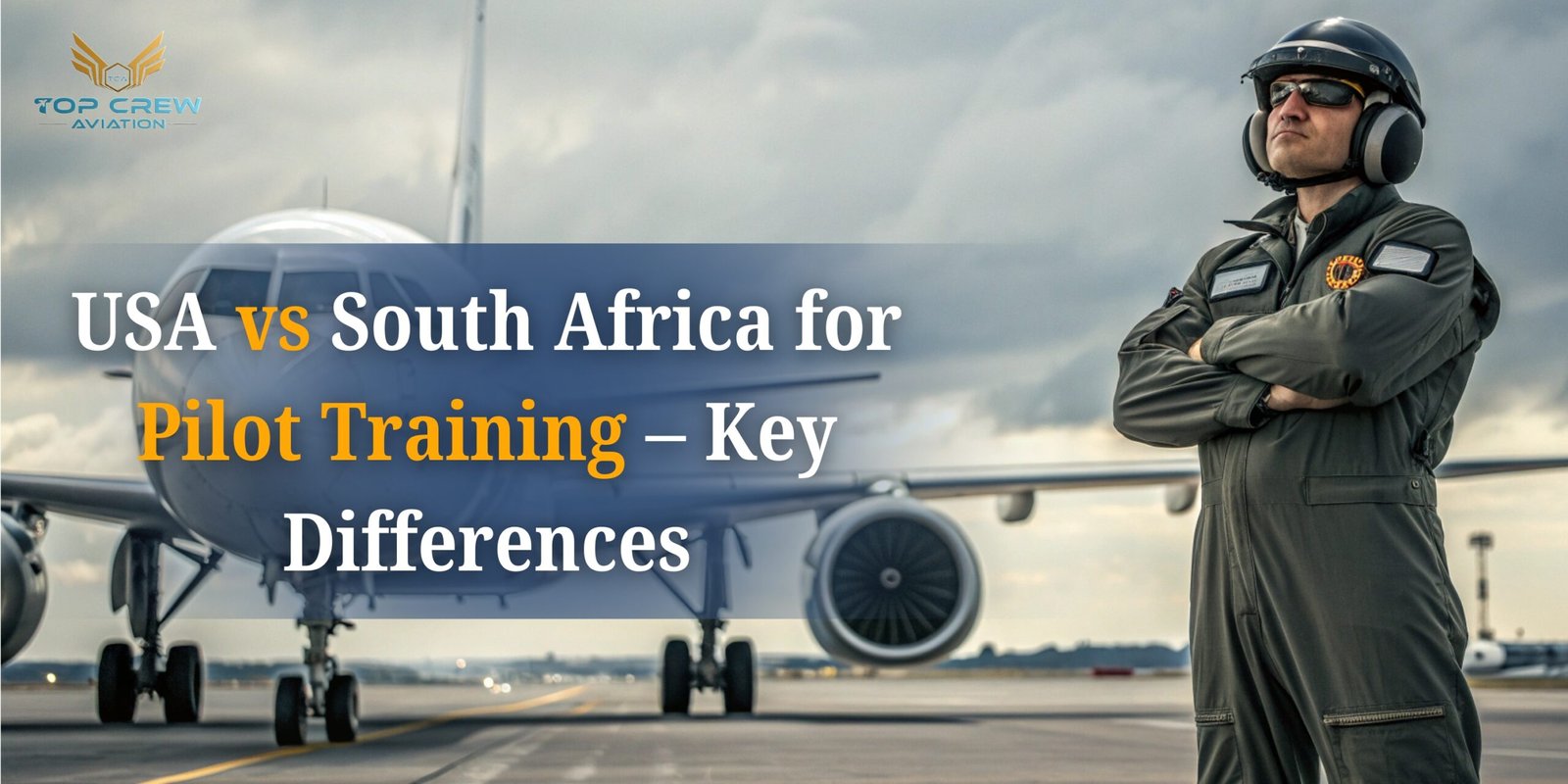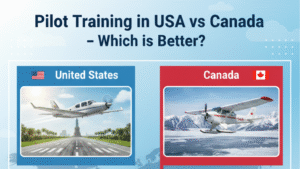Introduction
Choosing the right country for Pilot Training is one of the most important decisions for any aspiring pilot. The USA and South Africa are two of the most popular destinations for aviation students, especially from India. Both countries offer high-quality training, good flying weather, and globally recognized licenses.
However, there are major differences in terms of cost, training quality, flying hours, and post-training opportunities. In this detailed guide, we’ll compare pilot training in the USA vs South Africa and help you decide which country is the best fit for your aviation journey.
Overview of Pilot Training in the USA
The USA has one of the world’s largest and most advanced aviation training systems. The country operates under the FAA (Federal Aviation Administration), which sets global standards for pilot certification.
Students who choose pilot training in the USA get access to top-class infrastructure, simulators, and well-maintained aircraft fleets. Training in the USA usually involves:
- Ground classes for aviation theory
- Flight hours under FAA supervision
- CPL (Commercial Pilot License) training
- Multi-engine rating and instrument flying
The weather in most US states is ideal for flying almost all year, which helps students complete their pilot training faster.
Overview of Pilot Training in South Africa
Pilot training in South Africa is gaining popularity because of its affordable fees and globally recognized SACAA (South African Civil Aviation Authority) license. Many Indian students prefer South Africa because English is widely spoken and the training environment is friendly.
South Africa offers clear skies, lower air traffic, and a cost-effective lifestyle. The country also has many reputed flying schools that maintain international standards.
Typically, students complete their PPL (Private Pilot License) and CPL (Commercial Pilot License) under SACAA. After that, the license can be converted to DGCA standards when returning to India.
Training Cost Comparison: USA vs South Africa
One of the biggest deciding factors in choosing between the USA or South Africa for pilot training is the total cost.
| Training Component | USA (Approx.) | South Africa (Approx.) |
| Private Pilot License (PPL) | USD 12,000 – 15,000 | USD 8,000 – 10,000 |
| Commercial Pilot License (CPL) | USD 40,000 – 50,000 | USD 35,000 – 40,000 |
| Living Expenses | USD 1,000 – 1,500/month | USD 500 – 800/month |
| Total Estimated Cost | USD 60,000 – 70,000 | USD 40,000 – 50,000 |
As you can see, pilot training in South Africa is cheaper than in the USA. However, the USA offers faster completion and better global exposure, which justifies the higher cost for many students.
Flight Training Duration and Weather Conditions
In the USA, most flying schools offer pilot training programs that can be completed within 12–15 months if the student flies regularly. The weather is generally favorable in states like Florida, California, and Arizona.
In South Africa, pilot training usually takes around 14–18 months depending on weather and flight availability. The climate is good for flying, but sometimes local conditions like winds or seasonal changes can affect training schedules.
So, in terms of weather and duration, the USA has a slight edge.
Type of Licenses Offered: FAA vs SACAA
The biggest technical difference between pilot training in the USA and South Africa is the licensing authority.
- USA: Students are trained under the FAA (Federal Aviation Administration) standards.
- South Africa: Students follow the SACAA (South African Civil Aviation Authority) rules.
Both licenses are internationally respected. However, FAA licenses are more globally accepted, making it easier to get airline jobs or convert your license later.
When comparing the FAA vs SACAA pilot license difference, FAA offers wider international recognition, while SACAA is ideal for those planning to fly in Africa or Asia.
Quality of Flight Schools and Instructors
The USA has thousands of FAA-approved flight schools with modern aircraft and highly experienced instructors. The quality of training, flight safety, and simulator-based education are exceptional.
South Africa also offers excellent pilot training, though the number of advanced simulators and aircraft options might be slightly fewer compared to the USA. However, the training quality remains solid and cost-effective.
Both countries follow strict safety protocols and international training standards.
Visa Process and Student Requirements
For Indian students, getting a visa for pilot training in the USA involves applying for an M-1 student visa, which allows you to stay until your course is complete. The process is straightforward but requires financial proof and a valid medical certificate.
For pilot training in South Africa, you’ll need a study visa issued by the South African embassy. The requirements are generally simpler, and visa approval takes less time compared to the USA.
If you’re looking for a faster start, South Africa has an advantage.
Job Opportunities After Pilot Training
After completing pilot training in the USA, students often get opportunities for internships or time-building programs. Some may also apply for FAA Instructor (CFI) positions to gain flying experience.
In South Africa, students usually return home to convert their SACAA license to DGCA if they plan to fly in India. While the local job market is smaller, South African training is respected worldwide, and many graduates get jobs in the Middle East or Asia.
If your goal is global exposure and advanced aviation opportunities, the USA offers more options.
Conversion of Licenses for Indian Students (DGCA Conversion)
Whether you train in the USA or South Africa, Indian students must convert their foreign license to a DGCA-approved CPL before flying in India.
The DGCA conversion after foreign pilot training process includes:
- Applying for a DGCA computer number
- Passing DGCA ground papers (Air Navigation, Meteorology, and Regulation)
- Submitting logbooks and verification from the foreign authority (FAA or SACAA)
- Undergoing DGCA medicals
Both the FAA and SACAA licenses can be converted, but the FAA conversion process is slightly smoother due to better documentation standards.
Which Country Offers Better Value for Money?
When comparing the USA or South Africa for pilot training, it depends on your budget and career goals.
- If you want faster completion, advanced training tech, and global recognition, the USA is the best choice.
- If you prefer affordable training, good weather, and a relaxed lifestyle, South Africa offers great value.
Remember, both countries produce skilled pilots — what matters most is your consistency, training quality, and post-course experience.
Final Verdict – USA or South Africa: Which is Best for You?
So, which country wins the comparison — pilot training in the USA vs South Africa?
The answer depends on what you value more:
- Budget and Affordability: South Africa
- Global Career Opportunities: USA
- Faster Completion: USA
- Easy Visa and Lifestyle: South Africa
For Indian students, both options are excellent. If you can afford the extra cost, go for pilot training in the USA. If you want to save money and still get a quality education, South Africa is a great choice.
In both countries, you’ll receive solid training that helps you build your dream aviation career.
Conclusion
Choosing between the USA and South Africa for pilot training is not just about cost — it’s about your long-term goals. Both destinations offer great weather, skilled instructors, and globally respected licenses.
Whichever country you choose, make sure your flight school is approved by the local aviation authority (FAA or SACAA) and that your license can be converted by the DGCA if you plan to fly in India.
With proper planning, pilot training in either country can open the runway to your dream career in aviation.
Suggestion Blog URL:-



